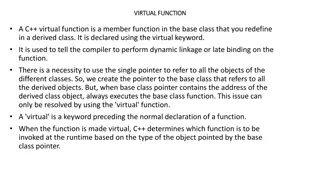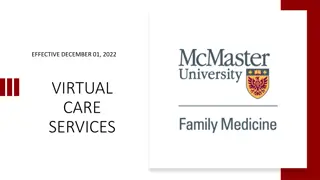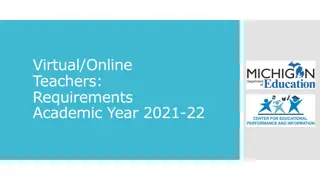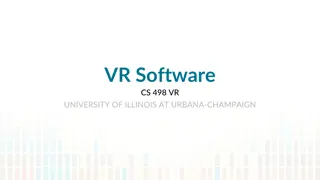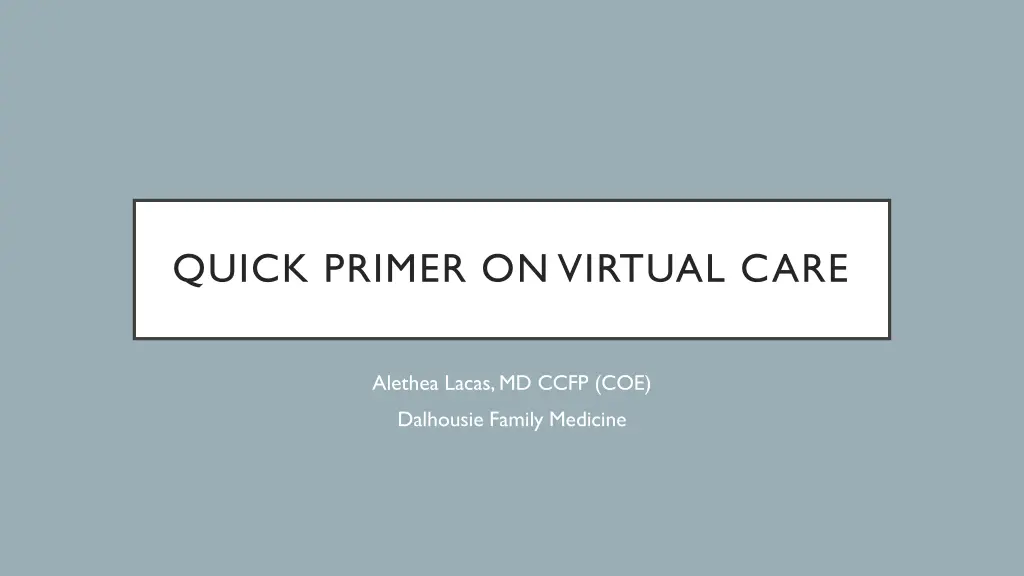
Virtual Care Best Practices for Healthcare Providers
Discover key insights on virtual care, including benefits, challenges, and best practices for conducting virtual visits. Learn from the experiences of healthcare professionals and understand the transition to virtual care in the context of the COVID-19 pandemic.
Download Presentation

Please find below an Image/Link to download the presentation.
The content on the website is provided AS IS for your information and personal use only. It may not be sold, licensed, or shared on other websites without obtaining consent from the author. If you encounter any issues during the download, it is possible that the publisher has removed the file from their server.
You are allowed to download the files provided on this website for personal or commercial use, subject to the condition that they are used lawfully. All files are the property of their respective owners.
The content on the website is provided AS IS for your information and personal use only. It may not be sold, licensed, or shared on other websites without obtaining consent from the author.
E N D
Presentation Transcript
QUICK PRIMER ON VIRTUAL CARE Alethea Lacas, MD CCFP (COE) Dalhousie Family Medicine
Who has worked in a virtual care setting? This might be via telephone or video platforms? Did people enjoy virtual care? POLL Were there benefits to providing virtual care? What were some of the challenges?
Understand best practices for conducting virtual care Review common options for how to work with a preceptor while working in the virtual care setting OBJECTIVES Identify resources that may be helpful to you as a resident starting to work in virtual care setting
BACKGROUND Covid-19 pandemic required quick pivot from traditional in-office visits to virtual care Virtual Care is likely here to stay (in some form) In many ways virtual care visits are the same as in-person visit Most of the differences are around the limitations of virtual care, the technology and flow of a supervised visit Patients are often satisfied with virtual visits
History is all! History taking is often better or more thorough. It can facilitate providing mental health care (both access and ease of encounter) ANECDOTAL OBSERVATIONS ABOUT PROVIDING VIRTUAL CARE Patients seem to appreciate virtual care visits. It can be more efficient. It can be harder when you don t know the patient. It can be exhausting working continuously from home. It is easier to be distracted while providing virtual care.
WHAT DO YOU NEED TO KNOW TO START PROVIDING VIRTUAL CARE? What technology will be used? Do you have a space that you can have private conversations with the patients? If you have tech or space concerns PLEASE speak with your preceptor or site director. Have you and your preceptor had a chance for an orientation to virtual care?
ORIENTATION TO VIRTUAL CARE Just as you would in a physical clinic you should review with your preceptor(s) the plan for virtual visits. When will you review with the preceptor? If not in the same location, how will you contact each other? If preceptor will be directly observing, is this via speakerphone or conference call? At what point of the encounter will they be involved in the encounter?
Ensure your phone number is blocked/private. Ensure that you are in a private and quiet space. Consider using headphones ESSENTIALS OF VIRTUAL CARE Introduce yourself to patient and confirm their identity. Consent them to virtual care and explain the flow of the visit. Let the patient know who is on the call if your preceptor is also listening. What to do during an emergency: Don t hang up on the patient!
Place your workstation in a location that protects the patient exchange from being seen, overheard or interrupted by others. Use a professional/neutral backdrop and good lighting. Ensure that you are dressed professionally. WEBSIDE MANNER FROM CMA VIRTUAL CARE PLAYBOOK Position camera so it is directly above the computer window with the patient s video image. Eliminate all distractions from your computer and surroundings Make extra effort to engage with the patient at all times and assure them that they have your full attention. http://www.cma.ca/sites/default/files/pdf/Virtual-Care-Playbook_mar2020_E.pdf
Just like you dont have non verbal cues from patients, they don t have non-verbal cues from you. So use your active listening skills! ACTIVE LISTENING After the patient speaks, summarize or use statements such as what I hear you saying is
If you have a template or macro for virtual care visits, use them. Template Consent Document consent to virtual care. DOCUMENTATION Exam Document any physical exam findings. Time Document time spent on phone with patient.
What can you gather during a telephone visit? Mental Status Exam PHYSICAL EXAM Breathing What else? Can the patient provide you with data?
Same rules and requirements around privacy, documentation, consent and limits of care. Document consent to virtual care MEDICO-LEGAL Be mindful of when you do need to see a patient in person and make these arrangements
After each call, at the end of clinic or after certain patients? When do you review with your preceptor? How do you communicate when you are ready to review? Text or EMR pop-up message to avoid interruptions WORKING WITH A PRECEPTOR When will the preceptor join the call or video appointment? Is it for the full visit, at the end, not at all? How will the preceptor join your call or video appointment? Merge calls vs speakerphone
Dont forget to get field notes and feedback about your virtual care encounters! Feedback can be about specifics of virtual care or the usual competencies. FEEDBACK If you are not co-located with your preceptor it may be harder to remember to do this. Make the time and remind your preceptor if this isn t happening.
RESOURCES ESSENTIALS OF TELEMEDICINE Virtual Visit Guidelines for Residents: https://www.cfp.ca/sites/default/files/pubfiles/PDF%20Documents/Blog/telehealth_tool_eng.pdf Telemedicine: The Essentials: https://medicine.usask.ca/facultydev/clinical_resources/documents/virtual-visit-guidelines-for-residents---for- web1.pdf Virtual Care Playbook for Canadian Physicians: http://www.cma.ca/sites/default/files/pdf/Virtual-Care-Playbook_mar2020_E.pdf Doctors Nova Scotia Virtual Care Tool Kit: https://doctorsns.com/sites/default/files/2020-05/toolkit-virtual-care.pdf
MORE RESOURCES Zoom for healthcare: https://www.cdha.nshealth.ca/telehealth-zoom/orientation-package-nshaiwk-primary-care-providers Virtual Care Tip Sheet NS College: https://www.dropbox.com/s/xbcgfthss3kk1y9/Covid%20Tip%20Sheet.pdf?dl=0 Pearls for Writing a Virtual Care Field Note: https://portal.cfpc.ca/ResourcesDocs/uploadedFiles/Education/For_Teacher/Emerging-Writing-ENG-v4.pdf








